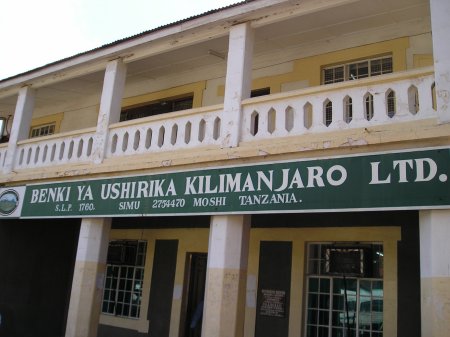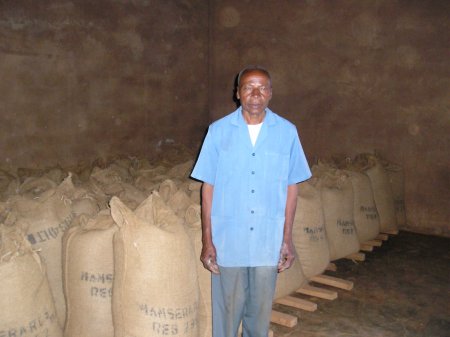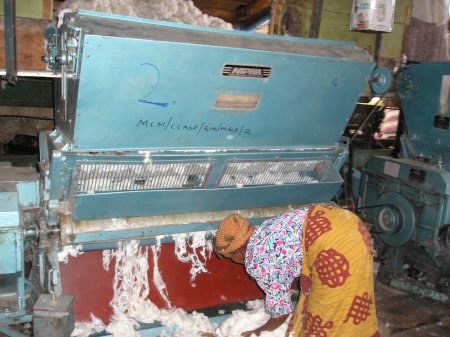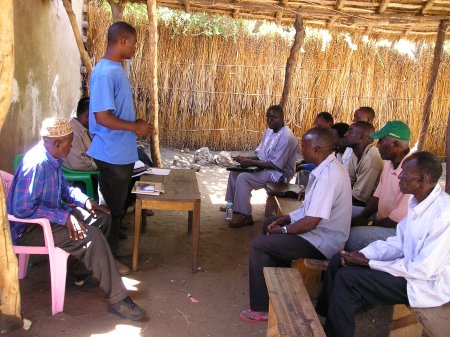Local Project Management
The Local Management Unit (LMU) is located in Pamba House, Dar es Salaam and headed by a three-member team:
- Ms Elizabeth Kimambo (Head and National Project Coordinator)
- Mr Fidelis Temu (Associate Project Coordinator for Coffee sector)
- Mr Mohammed Mbaga (Associate Project Coordinator for Cotton sector).
The two key stakeholders are the Tanzania Coffee Board and Tanzania Cotton Board. The Project is hosted by the Ministry of Trade, Industry and Marketing.
The Tanzania WRS Model
The key features of the Tanzania WRS are:
- Designated warehouse operators are private coffee curing factories and cotton ginneries.
- Depositors are mainly primary cooperative societies who market coffee on behalf of their members, though some medium-scale traders and cooperative unions are also participating.
- Financing is not so much for speculating on favourable price movements but to provide working capital, e.g. to the primary cooperative societies, allowing them to make initial payments to members while waiting for the crop to be processed for the market. The lead banks financing against Warehouse Receipts issued under the project are CRDB Bank, Exim Bank (Tanzania) Ltd. and the Kilimanjaro Cooperative Bank.
- Cured coffee is predominantly sold through the Moshi Coffee Auction. Payment is channelled through the Auction to the financing bank, allowing it to recover the loan provided and related charges.
- The system is primarily trust-based and does not involve a collateral manager or a regulatory body in overseeing the activities of the warehouse operators.
A Warehouse Receipt Act was recently passed by the Tanzanian parliament. In addition to providing a framework within which Warehouse Receipts can be issued, the Act provides for the establishment of a Regulatory Board to license and inspect participating warehouse operators.
Progress Made
Considerable progress has been made in piloting the WRS for coffee and cotton in Tanzania (further details provided in Coffee/Cotton Sector Pilots below). This progress and the promulgation of supportive legislation by the Government of Tanzania have helped create a platform for mainstreaming WRS in the country. So far the main achievements have included:
- Printing of secure Warehouse Receipts, the issuing of which will be regulated by the proposed Regulatory Board.
- Warehouse Operators and primary cooperative societies have been trained in warehouse standards and commodity quality assurance.
- Warehouse regulations and inspection manuals are under preparation to facilitate establishment of the Regulatory Board.
- LMU staff and other relevant key stakeholders were trained in warehouse inspection to enable them to enforce regulations/standards prior to the establishment of the Regulatory Board. The resource person came from the Zambia Agricultural Commodity Agency (ZACA) - set up by NRI to regulate the WRS for grains in Zambia.
- Arrangements have been initiated to institutionalise training in warehousing to assure availability of skilled professionals.
- The development of an effective and sustainable market information system is underway. This includes a website for disseminating project information as well as market related issues. The site will be transferred to the Regulatory Board once it is functional. Other means for disseminating market information will include radio bulletins, newspapers, television, newsletters and flyers. A training manual on market information is being prepared and will be available from the LMU and later from the Regulatory Board.
Coffee Sector Pilot
Coffee contributes over 17% of Tanzania's foreign exchange earnings and is mainly produced by smallholders (over 85%). Nearly 75% of coffee produced in Tanzania is Arabica.
Four warehouse operators are participating in the WRS pilot. These are Tanzania Coffee Curing Company (TCCCO), Mbozi Coffee Curing Company Ltd, Mbinga Coffee Curing Company Ltd, and Tanganyika Coffee Curing Company Ltd. The geographical spread of the operators cover the following regions: Kilimanjaro, Tanga, Arusha, Kigoma, Mbeya, and Mbinga regions.
There are over 50 coffee farmer groups using the Warehouse Receipt Systems. These are predominantly Primary Cooperative Societies. The table below shows quantities of parchment coffee deposited by these groups and the financing against these deposits by CRDB Bank, Exim Bank and Kilimanjaro Cooperative Bank Ltd over the past 4 seasons.
| Season | Parchment Deposits (kg) | Total Bank Finance under WRS (TZS) |
|---|---|---|
| 2002/03 | 8,269,507 | 4,697,692,852 |
| 2003/04 | 9,842,066 | 2,264,686,440 |
| 2004/05 | 15,297,250 | 8,653,345,500 |
| 2005/06 | 12,022,717 | N/A |

Farmers have reported receiving much higher prices under the WRS which are up to 45% more than prices paid by the private traders. Anecdotal evidence also suggests that the quality of the coffee delivered by the primary level organisations is constantly improving. The improvements have been attributed to the higher prices linked directly to higher quality coffee and the improved traceability systems enhanced with the use of WRS. Primary level farmer organisations using the WRS are also showing increasing sophistication in their marketing strategies as the case below illustrates.
Mamsera Rural Cooperative Society
The Mamsera Rural Cooperative Society (MRCS) is a coffee marketing groups and has a membership of 1,024 people. Coffee is bought from members and non-members on the basis of quality [Special, Parchment 1 and Parchment 2]. This procurement system is aiding in the production of higher quality coffee.

For ‘first payment’ to producers, MRCS has to borrow money from the banks at going interest rates. The MRCS opted to deposit with Rafiki Coffee Ltd Company, a coffee curing factory venturing into lending under the WRS because of the lower financing cost. Rafiki offers advances against the deposited parchment coffee at interest rate of 12%, instead of 20% on loans from the Kilimanjaro Cooperative Bank (KCB) previously used. As is the case with groups borrowing from KCB and depositing with other curing factories, loan repayments are completed when the coffee is sold through the Moshi Coffee Auction.
Besides the coffee business, the MRCS is involved in other activities, each of which is assigned its own budget and handled separately:
- hardware business
- brick making
- inputs business
- coffee nurseries
Cotton Sector Pilot
Cotton contributes about 14% of foreign exchange earnings to Tanzania’s economy. More than 95% of Tanzanian cotton is grown in the Western Cotton Growing Areas while the rest comes from the Eastern Cotton Growing Areas. Cotton production is dominated by smallholder farmers, harvesting on average 600kg seed cotton per hectare.
The cotton pilot is currently only operating in Moshi. The Tanzania Cotton Board is currently running the ginnery on a short-term lease from the Kilimanjaro Native Cooperative Union (KNCU) who in turn is offering toll (contract) ginning services to primary societies. The main depositor is the Oridoyi Rural Cooperative Society (a smallholder primary society) from Manyara Region in Eastern Tanzania.

The Oridoyi Rural Cooperative Society was established in 1995 and has a current membership of 600 farmers. The Society began using the WRS to market their cotton in 2003/04 season. The process of depositing involves the primary society sending seed cotton to the Moshi Ginnery. Because of the toll-ginning service offered, the primary society is able to use the deposited seed cotton as collateral, allowing them to obtain finance of TZS390 million in the 2005/06 season from the CRDB Bank. The loans obtained are used to make initial payments to the members. The initial payment to the producer is often set close to the minimum price set by the Tanzania Cotton Board at the beginning of each season.
After ginning, the primary society markets the lint and cotton seed. In the 2004/05 season, the group was able to market cotton lint directly to a UK-based merchant, with the assistance of the Tanzania Cotton Board. Proceeds from the sales are channelled through the bank, allowing the bank to recover loans and related interest costs and charges. The balance is credited to the primary society, which deducts operating and administration costs after which point it can opt to make a second or third payment to the depositors. During the 2003/04 season, the society financed expansion of area under cultivation by about 4 hectares for each member from the profits made from the sale of lint and cotton seed. This explains the substantial increase in output the following season (2004/05) as shown in the Table below.
| Season | Seed Cotton Deposited under WRS (kg) |
|---|---|
| 2002/03 | 103,273 |
| 2003/04 | 229,470 |
| 2004/05 | 826,000 |
| 2005/06 | 1,200,000 |

However, the WRS cotton pilot was seriously hampered by the use of old gin stands which were in operation at the Moshi ginnery. Following recommendations by the WRS project, four gin stands were imported from India with funding from the Ministry of Cooperatives and Marketing (MCM). This installation of new gin stands improved ginning efficiency substantially. The efficiency in ginning is expected to substantially increase the net income of the depositors, through reducing the cost of servicing loans and obtaining higher lint quality.
The main challenge for the WRS Project team is to expand use of the system to the Western Cotton Growing Areas. The LMU continues to work tirelessly to replicate the Oridoyi success story in the West. Further to this, there is need to identify ginners willing to provide toll ginning services to the farmer groups intending to use the WRS. The financial benefits of a ginner providing toll ginning services to producers, and for cotton producers to market lint cotton instead of seed cotton is being explored. The report will be available soon.
